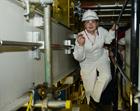Female engineers inspired by visit to HMS Queen Elizabeth
Sixteen of the country’s best and brightest young female engineers were filled with inspiration after visiting Britain’s biggest warship HMS Queen Elizabeth.
The undergraduates from the Brunel University branch of STEM (Science, Technology, Engineering and Maths) were given a personal tour of the 65,000-tonne new carrier – unveiled to the world last week as Her Majesty the Queen officially named the ship in Rosyth.
The London-based students were invited to tour the state-of-the-art warship as part of an initiative to promote the role of women in engineering in general and provide the visitors with an insight into the role of female engineers in building the carrier with the Aircraft Carrier Alliance and running the ship as a Royal Navy engineer officer.
Babcock engineers Jen McGinley and Laura Porter did the former, while from the ship’s company Petty Officer (Weapon Engineer) Steph Simpson and Chief Petty Officer (Marine Engineer) Lyndsay Oldridge shared their experiences.
PO Simpson offered an insight into the Queen Elizabeth’s innovative automated weapons-handling system and communications network and CPO Oldridge provided her expertise on the marine engineering side of the ship – the power and distribution system and its component elements, and the ship’s systems, from chilled and fresh water to sewage treatment plants and fuel management.
The highlight for the students was a comprehensive tour of the carrier from the bowels to the bridge.
They were shown one of the smaller diesel engines – far larger than any of them had ever experienced before.
When coupled with the Queen Elizabeth’s other power plants, the ship generates approximately 110 Megawatts of power –enough to power a town roughly the size of Swindon.
All the visitors – studying across the engineering spectrum: mechanical, social, civil, biomedical and aerospace – were struck by the scale of the Queen Elizabeth project (each of the two ships comprises in excess of 17 million parts).
“The sheer size and precision of the operation gave me a sense of the incredible scale of enterprise involved. As a young designer, I have been left inspired by this unforgettable experience,” said industrial design student Cara O'Sullivan.
An inspired Olivia Gutierrez added: “A stunningly inspiring opportunity that reminds me why engineering is the career to follow.
“This is a truly breath-taking engineering feat that has got me wanting to be part of an engineering project as colossal and exciting as HMS Queen Elizabeth.”
And from communications technology student Lilian Kasem: “The trip was great; it was a new and exciting experience.
“I learnt a lot about the engineering behind a warship and how the Royal Navy deals with the design, build and maintenance of such a large project. Interesting fact: everything is inside out.”



